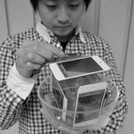
Kodai Horita
Innovative Technology Development Dept.
Business Development Div.
Dentsu Inc.
Many people may associate AI chatbots as a tool that enhances business efficiency by automating FAQs. However, the role of AI chatbots today is expanding.
In this article, we focused on the AI’s ability to ‘engage in chit-chat’, a faculty uncovered from the know-how Dentsu accumulated through past applications of AI chatbots. We looked at a familiar AI chatbot named Rinna, and examined the possibilities of its communication abilities with human beings.
Kodai Horita, Innovative Technology Development Dept., Business Development Division, Dentsu Inc., will present the topic along with the hypothesis and verification test results.
If you’re going to talk about yourself, what kind of AI chatbot would you open up to?
Case studies of AI chatbots Dentsu has worked with in the past have been introduced in this series before.
Past articles of AI chatbot case studies (available in Japanese):
- An AI primary school student living in Shibuya Ward suggests how to shape “Shibuya Mirai”
- This is what happens when you teach an AI chatbot to work as a car salesperson
Through these initiatives, we began to realize that users found it easier to talk about themselves to a chatbot with character. For example, users responded well when an AI chatbot with character asks a question rather than an AI chatbot without character.
In addition, some of the users who engaged in a conversation with an AI chatbot revealed that:
- they would talk about their day with the chatbot over drinks at dinner, or
- when they felt shaken after an earthquake, they could share their feelings with the chatbot.
Such responses indicate that conversations give deeper insight into people’s feelings.
Using these case studies and the know-how Dentsu has accumulated, we thought we could leverage these ‘chatbots with character’ to gain a deeper understanding about the users.
Based on this hypothesis, we teamed up with Toyota Motors and rinna, famous for the former AI high school girl named Rinna (who graduated from high school in March 2019) *link in Japanese, to develop ‘a chatbot designed exclusively for killing time’, as indicated in the title of this article, to undertake a verification test.
The birth of “That’s Life”, an AI chatbot designed exclusively to kill time
The opportunity to develop an AI chatbot exclusively for killing time appeared in front of us when Toyota Motors approached us with a research and development request: “When our customers visit our dealers, we want them to relax and feel comfortable during their wait. And we want to use that time to get to know them better and engage them in a better way.”
So we came up with a new solution to combine ‘an AI chatbot that can help get closer to users’ and ‘an AI chatbot that can listen to users and obtain personal information’ so that we could accomplish both objectives: chat with users and gain more information about them. For the former we used “Rinna (link in Japanse)”, an AI chatbot good at chatting with people, and for the latter we used “Kiku-Hana (link in Japanese)”, Dentsu’s chatbot that specializes in understanding the Japanese language.
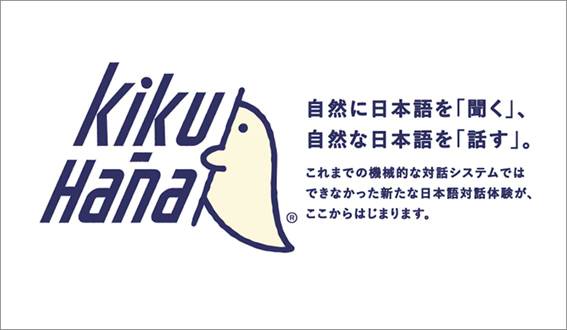
We combined two types of AI chatbots and tried keeping the customers at the Toyota dealerships entertained during their waiting time while we engaged them in a conversation to capture information that would help us get to know them better. This was how “That’s Life”, the AI chatbot designed exclusively to kill time, was born.
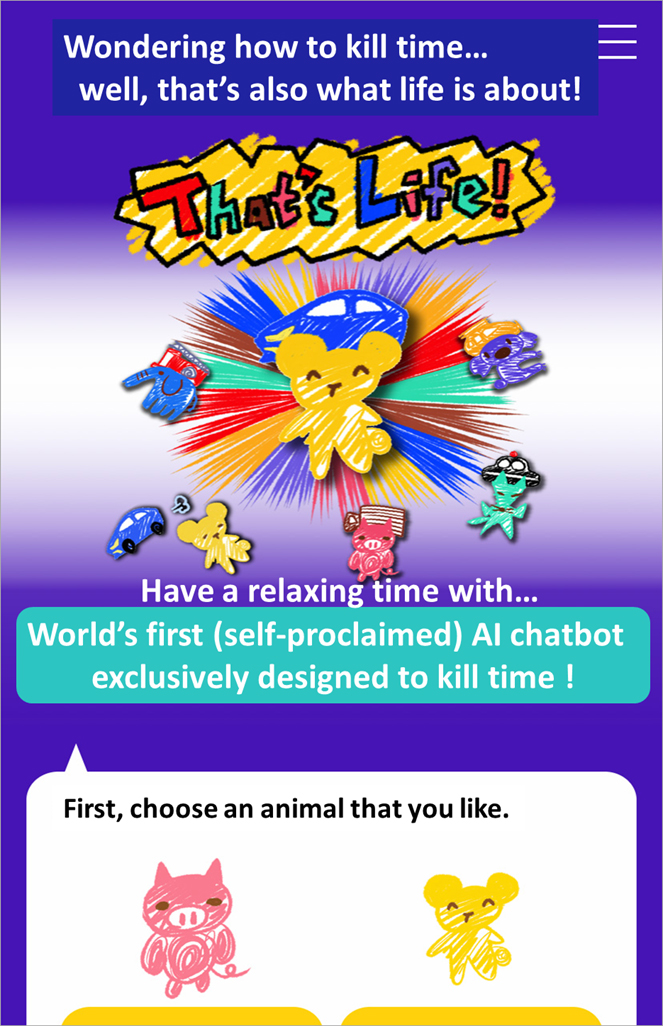
“That’s Life” is a chatbot that has the appearance of a hand-written bear named “That’s” who is a bit slack but lovable, loves to chat, and enjoys fortune-telling and playing games. I will explain its specific design in the next section.
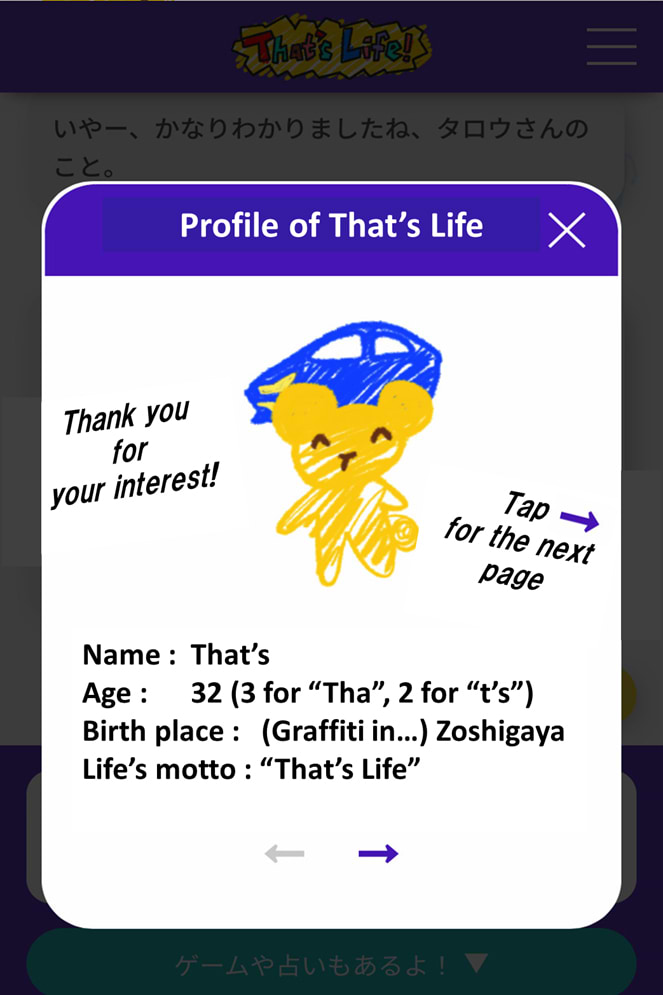
The essential character required in a “chit-chatting AI chatbot”
There were extremely difficult challenges that we had to overcome in the development process of an AI chatbot that chit-chats. Our challenge started from dealing with the difficulty of interpreting conversations spoken in Japanese.
We can construct a highly accurate level of conversation for an English-speaking chatbot because the English language has a space in between words and the grammar is quite explicit. In contrast, the Japanese language, especially in spoken form, often omits the subject or predicate, and you need to know the content of the previous sentence and the sentence that follows in order to understand the full context. This makes it difficult for AI to fully grasp the meaning of conversations in Japanese.
We also focused on a communication skill unique to Rinna that no other AI has, which is to respond to any comment by any user and to start a conversation, and adopted it for “That’s Life”. It is a perfect solution when the goal is to respond to everything the customer says so the chatbot can engage in a lively conversation and improve the relationship. The chit-chat becomes fun and interesting if the response is spot on, but there is also a risk of the chatbot giving a response that is totally off.
What is most important is to keep the customer entertained and engaged. If the customer doesn’t enjoy the exchange, the conversation will not last. So how do we deal with that problem? The key is to give the chatbot some ‘character.’
For instance, when chatting with “That’s Life” there are times the user feels that he or she is not getting through. At those moments, if the chatbot is adorable or has a bit of a mean streak to its character that makes the user think, “It’s just the nature of the chatbot,” the impression becomes different. In order to engage in an interesting conversation, it is essential to first ensure that the user sympathizes with the chatbot character and finds it likable.
We designed “That’s Life” focusing on entertaining the customers while creating a lovable character that people would forgive, even in uncomfortable situations during conversations that take place in Japanese. We decided to adopt a sloppily scribbled character, which gives the impression that what it says or how it speaks may sometimes be sloppy, but it can be forgiven because it is adorable.
Taking advantage of its ‘sloppiness’, whenever there was a bump in the conversation, we designed “That’s Life” to apologize saying, “Sorry I’m a bit sloppy,” so the customer wouldn’t feel uncomfortable if the conversation wasn’t going smoothly.
We also applied its character in the logic for gaining personal information about the customer.
To approach users with logical questions and responses to their answers, “Kiku-Hana”, the chatbot developed by Dentsu, was adopted. However, if the chatbot would suddenly ask in the middle of a conversation, “By the way, what is troubling you lately?” it is obvious that users normally would not give an answer. Therefore, whenever the conversation was shifting to a personal matter, the ‘sometimes sloppy’ character would become dominant and the chatbot would first start talking about itself.
We also tried to make it easier for users to talk about themselves by ‘sloppily making a sudden change of subject’ a few times during the chat.
An example is shown on the screen page below where “That’s” starts to confide in the user about something that has been on its mind.
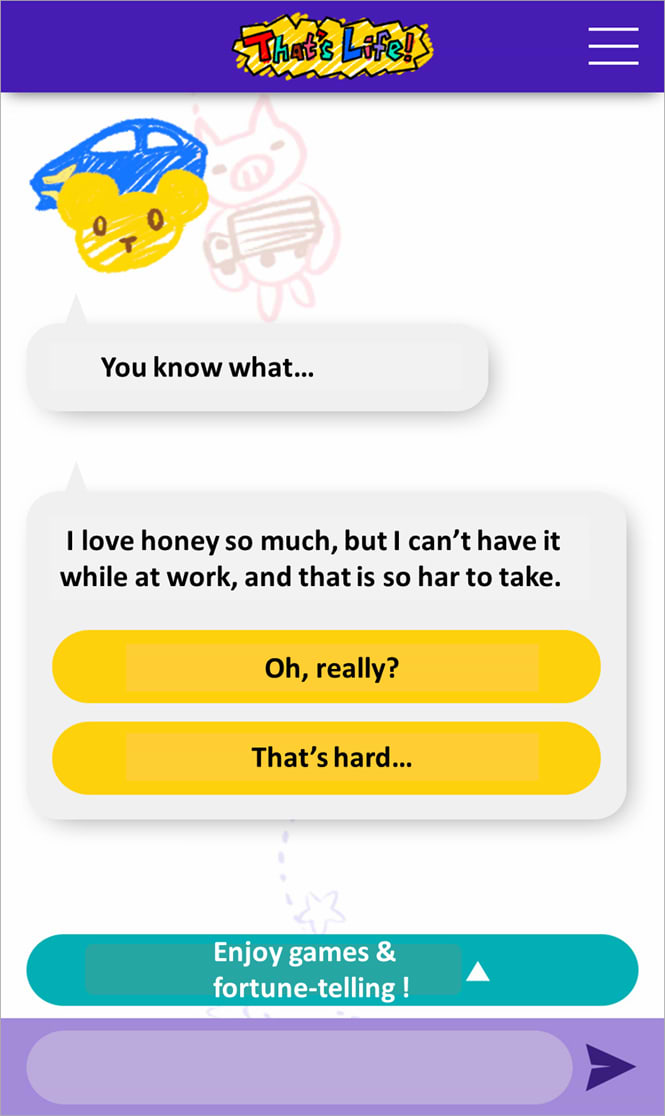
Later on, “That’s” thanks the user for listening…
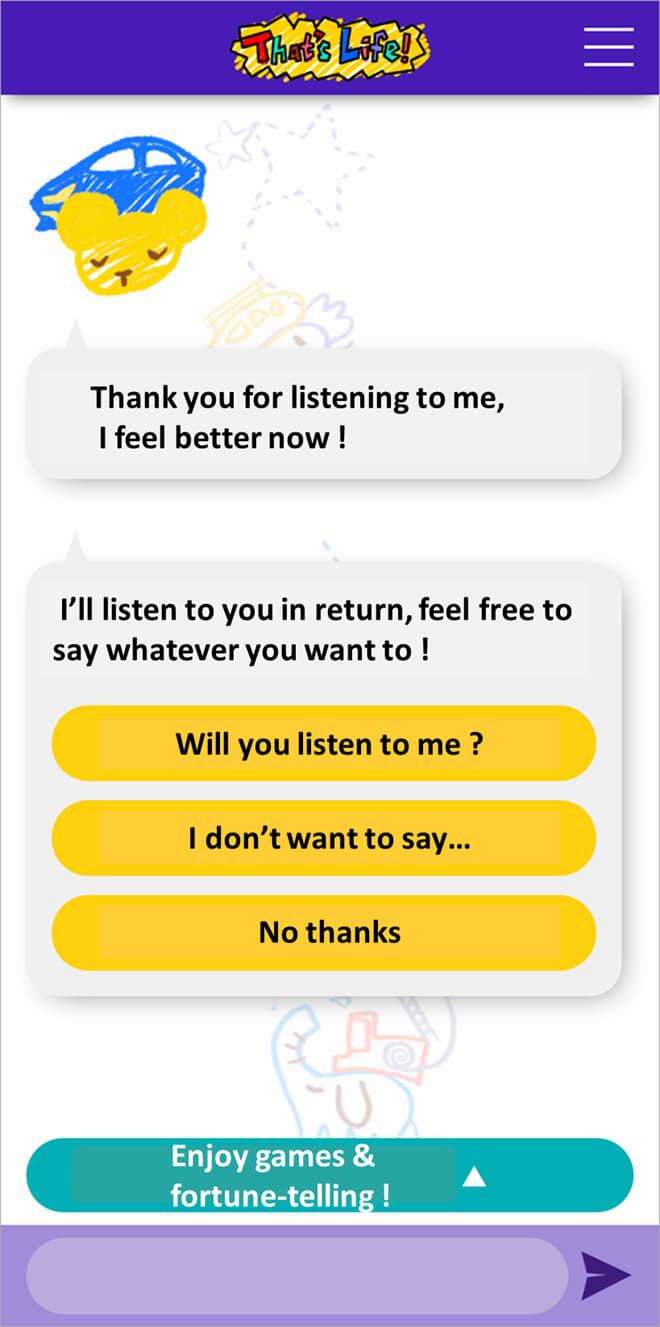
…and goes on to ask if there is anything the user would like to share.
In past case studies, we also found that such opening sentences are effective in easing any psychological hurdles that the user may have during the conversation with the AI chatbot.
The AI chatbot can be used as a chance to gain insight about users
A verification test for “That’s Life” was put into effect from January 15 at the Netz Toyota stores in Obihiro, Hokkaido Pref. and in Toyama.

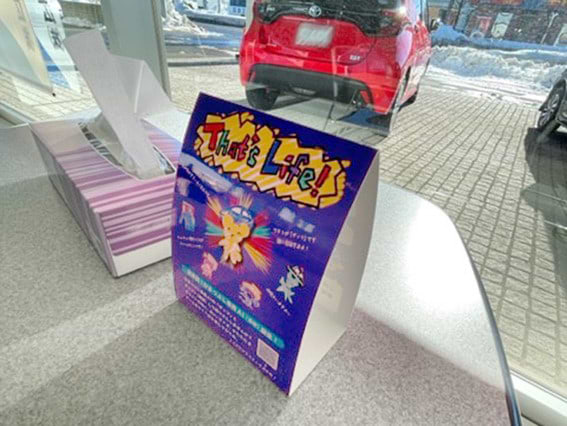
Through this verification test, we can improve the communication between the AI chatbot and the users to gain insight about them and use the information for the benefit of the customers. We are still in the testing stage, but Mr. Takanori Hirakoshi, a Toyota staff who observed the exchange between users and the AI chatbot enthusiastically commented, “The synergy of the dealership staff and the AI chatbot will allow us to establish a more meaningful communication with our customers, and we can also provide our customers with a greater experience and service.”
An AI chatbot cannot communicate simultaneously with multiple people. However, they have the potential to obtain a deep insight into the other person in a one-to-one exchange, and to provide the best information or service to that person.
Let’s say the AI chatbot learned from a chat with a user that the person usually has a drink during dinner at a certain time. Taking the conversation to a deeper level, we can find out more personal details and preferences, such as: what the user likes to munch on with the drink; whether the user drinks alone or with others; or what specific drink the user likes to have. If we find, for example, that the user prefers to drink something refreshing on Wednesdays because he/she goes to the gym and works out before dinner, we could recommend the best alcoholic beverage for the user to drink on Wednesdays.
From now on, companies that engage in one-way communication will need to actively seek ways to gain a better understanding about their customers if they want to increase the rate of their products or services being chosen. If companies want to get closer to their customers and increase understanding and support from customers towards their business, getting to know customers on a more personal basis becomes crucial.
If AI chatbots can be accepted as a tool to ‘understand users’, I personally believe that companies would be able to deliver better services to each customer they engage.
Related Link
AI chatbots give a glimpse into the communication style of the future (Japanese language only)
